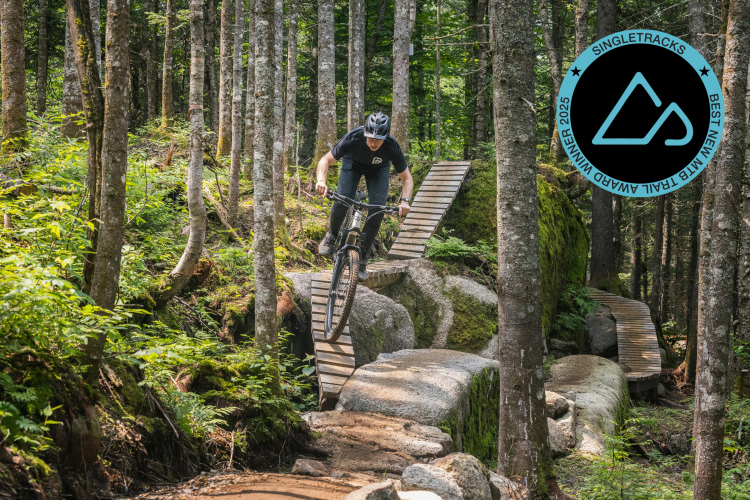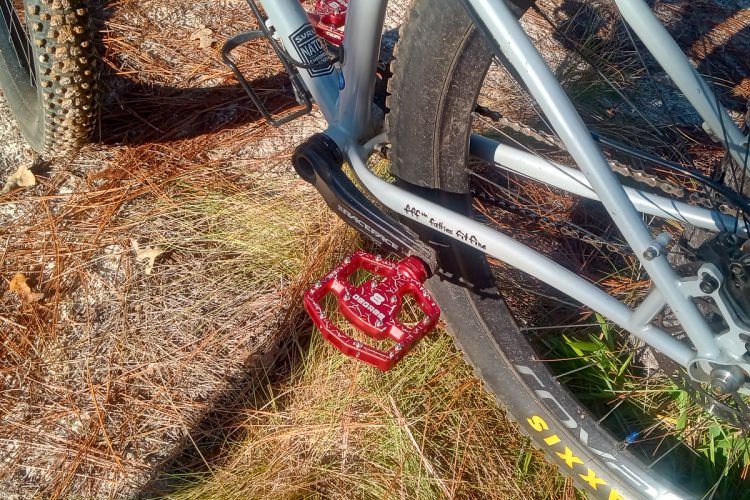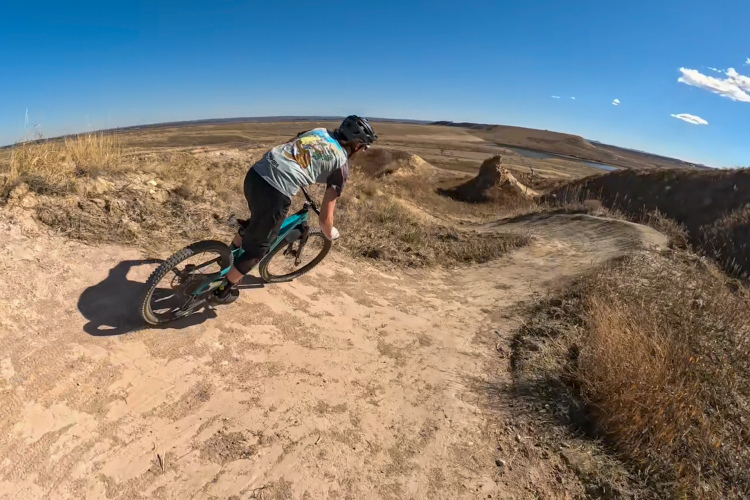
Smashed kneecaps, broken forearms, skull fractures, gnarly, full-thickness lacerations and sutures. (“Woah, that’s my muscle fascia!”) Sound familiar? Is that because you’re one of the statistics?
If general participation in extreme and adventure sports required a blanket contract, this clause would most surely exist: “Ride at your own risk.” A certain and expected amount of dare is foundationally intermingled with the attraction to the sport – this is known when the decision is made to partake. But, everyone starts out inexperienced, and everyone has “off days.” Plus, each time someone upgrades a category, or changes up their focus from XC to enduro, for example, fresh skills need to be obtained. New is always new, and a period of learning cannot be avoided. Because these stipulations exist naturally, any ride can become a gamble.
Mountain bikers have to be confident and comfortable enough to accept the risks of the sport while simultaneously maintaining sufficient awareness to avoid complacency. Complacency ultimately leads to defeat, a historical adage stated by many ancient religions and philosophies. It definitely applies to sport. The terrain will always win when pride or routine takes over.
Noticeable or sudden feelings of anxiety or uncertainty also follow suit – if the gut says to hold back, maybe you should listen to your primal intuition?
No matter how careful you think you are, a trip to the emergency room can happen like magic. (We’ve all had those moments where you crash because of “nothing.” Godsmack!) One thing ALL riders can do is armor up. Helmets shouldn’t even need to be mentioned in an article about mountain biking. That being said, many novices aren’t sure when it is appropriate (for lack of a better term) to start throwing on other types of protective gear, such as knee and elbow pads.
Furthermore, for riders that are new to enduro, downhill mountain biking, or freestyle, what about neck braces, spine guards, or even full-body protection? And which brands are best? All of these questions are legitimate and certainly should be addressed, but that is why there are bike shops and websites (llike singletracks.com) that provide quality reviews and recommendations by people that actually use the stuff.

The Dirt Can Hurt!
Still weary, or simply curious? Here is a juicy lineage of the science behind injury reporting in mountain biking, along with current statistics from legitimate medical sources.
Researchers began analyzing injury rates associated with off-road cycling in the 1990s, about 10 years after the sport of mountain biking really started to take off. One of the first major studies was conducted by Dr. Ronald Pfeiffer of Boise State University, ID, in 1994, done in conjunction with information provided by the National Off Road Bicycle Association (NORBA). According to the data provided on that season’s elite/pro racers’ injury statistics–which did include both men and women–the legs were the part of the body that sustained injury most often. In addition, the most common type of injuries seen were contusions and wounds.
At the time, inadequate information existed on recreational riders, which limited applicability of many study results to many that participated in the sport as a hobby, raced in a lower category (sport), or were just starting out. Unknown were real numbers and risk factors associated with fractures and other soft tissue injuries, adequacy of helmets in the prevention of head trauma, etc.
By the year 2000, about 900,000 adults in the US had participated in mountain bike racing, and about 7.1 million adults rode in some fashion off-road, according to information derived from NORBA and USA Cycling. Science followed the thriving trend. In 2002, Pfeiffer, along with Dr. Robert Kronish of San Jose State University, CA, conducted an updated, comprehensive scientific review of acute, traumatic injury prevalence in both competitive and non-competitive cyclists.
Overall, the data they compiled from the UCI, NORBA, and other international and national sources, suggested anywhere from 50-90% of riders have sustained some type of legitimate injury–mostly lacerations and abrasions, followed by fractures–and injury was significantly less likely to occur during a race or event. Going over the bars (OTB) was reportedly the most common cause of serious injury, which correlates with the rise in downhill racing. And, because going OTB was reported so frequently, it’s expected that head, shoulder, and upper torso/extremity trauma rates followed suit, with higher reported rates among riders without helmets.

In 2006, the Journal of Trauma-Injury Infection & Critical Care, published a 10-year review of mountain biking injuries that required trauma center admittance in the greater Vancouver area. Between 1992-2002, 399 patients sustained 1,092 injuries that required serious medical attention at one of three trauma centers included in the study – that’s an average of three injuries per patient. Approximately 66% of the patients required surgery, and one patient died.
The most frequent type of injuries were categorized as orthopedic (fractures, dislocations, tendon and ligament damage), followed by head (loss of consciousness and closed head trauma), and neck/spine injuries (mostly cervical spine, with 1 in 4 injuries involving the spinal cord). The most commonly fractured bones were the tibia and radius. In addition, the overall injury rate was increasing–it tripled over the investigated 10 years.
Another review of US emergency department admissions reported that 217,433 patients were treated for off-road mountain biking injuries between 1994-2007, which averages to be about 15,000 people per year (see figure below). The majority of patients suffered arm, collarbone, and shoulder fractures, and riders between the ages of 14-19 were most likely to sustain a traumatic brain injury (TBI). However, in opposition to the Vancouver study, these researchers found that the total rate of injury significantly declined over the 13 years, even though the number of adults that have reported mountain biking at least once reached more than 8 million in the late 90s, but steadily decreased thereafter. This could also be due to developments in bike technology (disc brakes, dual suspension), allowing for better bike handling, and improved helmet construction.

Progression of the Sport
Since then, many areas of the sport have branched out and flourished, especially downhill. As bike technology has progressed, so have the challenges we are taking on – slopestyle, freeride, super D, urban downhill, and any Red Bull or Crankworx event–all complete with near-vertical drops and crazy-ass lines winding through historic villages and canyon lands.
Whistler Mountain Bike Park reported 898 injuries during the 2009 season alone, according to data from the Whistler Health Clinic. Of the injuries, 420 were fractures, and 11.2% of the patients had sustained some type of TBI. Nearly 9% of patients had to be evacuated to a higher-level facility, seven of them by helicopter:

A 2015 study published in the British Journal of Sports Medicine aimed to analyze the rate and cause of injury in elite/pro downhill riders over the course of one season. Among the 249 riders involved in the study, the most frequent location of injury was the lower leg, and the pros had a significantly lower rate of injury when compared to the elite riders. In addition, nearly 41% of the severe injuries kept the athlete off the bike for more than a month.
The majority of injuries were found to be caused by riding errors. And, in opposition to earlier conclusions, an injury during downhill riding was more likely to happen during competition versus practice.

We Have Learned A Lot
Injury reporting and research techniques have improved greatly. Scientific consistency is always essential, and fortunately, it is what we are receiving. In the last 25 years we have been able to determine that intracranial hemorrhages are the most common cause of death among mountain bikers, even though upwards of 90% of riders wear helmets. In response, helmet technology has improved greatly, and fatalities are extremely rare. In addition, most injuries occur during competition or other planned events (tricks, jumps), so safety guidelines established by researchers, manufacturers, and the sport’s governing entities have followed suit.
It is essential to note that many riders reported in these studies were wearing some additional type of body armor. What does this mean? If riders can get injured with armor, they can REALLY get injured without it. Basically, if you’re thinking about it, wear it.
You have but one body, and being safe is way better than learning the hard way, even though a lot of us have ironically chosen to gamble. What’s your excuse?




Thank you to the following for donating photos of their personal carnage (top to bottom): Aaron Sublett (broken neck), myself (abrasions, fractured radius), Justin Kyle (crushed C4 and C5), myself (full-thickness laceration + 15 sutures), Doug Gangi (sideways fall), Moe Hutchenson (elbow sutures), Moses Eason (breaking his wrists in action), Kenny Bennett (knee laceration + 18in of continuous sutures), Colin Moakley (elbow laceration), and Andrew Putt (crashed face first into a creek bed while racing enduro).
References:
Ashwell, Z., McKay, M. P., Brubacher, J. R., & Gareau, A. (2012). The epidemiology of mountain bike park injuries at the Whistler Bike Park, British Columbia (BC), Canada. Wilderness & environmental medicine, 23(2), 140-145.
Becker, J., Runer, A., Neunhäuserer, D., Frick, N., Resch, H., & Moroder, P. (2013). A prospective study of downhill mountain biking injuries. British journal of sports medicine, bjsports-2012.
Carmont, M. R. (2008). Mountain biking injuries: a review. British medical bulletin, 85(1), 101-112.
Carmont, M. R. (2013). Mountain Biking Injuries. Adventure and extreme sports injuries (pp. 225-245). Springer London.
Kim, P. T., Jangra, D., Ritchie, A. H., Lower, M. E., Kasic, S., Brown, D. R., … & Simons, R. K. (2006). Mountain biking injuries requiring trauma center admission: a 10-year regional trauma system experience. Journal of trauma and acute care surgery, 60(2), 312-318.
Kronisch, R. L., & Pfeiffer, R. P. (2002). Mountain biking injuries. Sports medicine, 32(8), 523-537.
Nelson, N. G., & McKenzie, L. B. (2011). Mountain Biking–Related Injuries Treated in Emergency Departments in the United States, 1994-2007. The American journal of sports medicine, 39(2), 404-409.
Pfeiffer, R. P. (1994). Off-road bicycle racing injuries–the NORBA Pro/Elite category. Care and prevention. Clinics in sports medicine, 13(1), 207-218.
Sharma, V. K., Rango, J., Connaughton, A. J., Lombardo, D. J., & Sabesan, V. J. (2015). The current state of head and neck injuries in extreme sports. Orthopaedic journal of sports medicine, 3(1), 2325967114564358.










9 Comments
Dec 23, 2016
Dec 23, 2016
Dec 22, 2016
I've had my share of injuries, several of'em worse than that shown in the pictures. My favorite battle story happened at Warrior Creek trail in Wilkesboro, NC. It was about 95 degrees that day, and the trail is about 15 miles. Consequently I was wishing I owned a non-full face helmet. Thank God I didn't. That trail has literally hundreds of awesome berms, and I was hitting a particular one very fast. I rode all the up to the top, were not many people ride, and consequently is less smooth. I was halfway through when trouble struck. Suddenly I was no longer riding my bike, but flying through the air. I flew 6.5 feet, landed on my feet and rolled another 20 feet down the hill. In so doing, I smashed the side of my head and sustained several medium level cuts and bruises on my wrist, side, and shoulder (all left). I would have easily broken my jaw if hadn't worn my full face helmet. I also was wearing my GoPro camera, which captured all the epic footage. What happened was there was this vine/root thing hanging down across the face of the berm. I guess it caught the front wheel, or its spokes, and launched me over the bars and into the air. I have always had excellent reflexes, and they certainly saved me then. After recovering my bike(and my composure) and rode the rest of the 7.5 miles left on my ride. I always have rode with a full face helmet, and this crash and the potential for disaster it had just reinforced my opinion: there is no such thing as too much armor. Ever.
Dec 23, 2016
Ego heals quicker than broken bones as we grow old.
Dec 22, 2016
I always wear helmet + gloves and of course have had plenty of injuries (including broken ribs just a couple of months ago). I am not, however, riding bike parks or downhill courses.
But I've always hesitated to wear pads/armor etc. because it seems they would only help for superficial injuries (scrapes/cuts), and there's no denying they are hot and not that comfortable. I'd be interested in any information (even anecdotal) about how effective they are.
Dec 23, 2016
I was surprised to find little, conclusive research on helmets - most of the studies had to do with impact on public health policies. There is an older study (1995) that says helmets did nothing to reduce head injury rates, and a few updated studies (early 2000's) from single hospital investigations that showed a decrease in head trauma injuries in cycling w/ helmet use.
Anecdotally, I personally would have benefitted from elbow pads on two separate occasions - I've broken both my elbows while mountain biking. My friend Ken just got in a pretty gnarly mtb crash a few days ago, and without a helmet, he would have been seriously injured. He broke his hand and has stitches in his face. His helmet destruction is probably one of the worst I've seen after a crash, and I believe it's safe to say it DEFINITELY prevented him from sustaining head trauma.
Dec 22, 2016
Dec 29, 2016
I will never ride without a helmet due to a crash I suffered early on in my mountain biking career -- gloves for the same reason. I haven't got that personal confidence in any other piece of protection. Nothing short of full body armor over my chest would have prevented my broken ribs.
I have a friend whose position is that wearing armor will simply make you take more risks. To be honest this is the main reason I am leaning towards getting some more protective gear -- I think I am too risk averse and ride below my level consistently.
I ride in northern colorado, where you get no downhill for free and are guaranteed to be pushing your way up steep climbs no matter where you go. So it's hard to want to carry that stuff up (let alone wear it).
I think I'll get some elbow and knee pads, stick them in my bag for the climb, and then wear them on the way down. Thanks for your article!
Dec 23, 2016